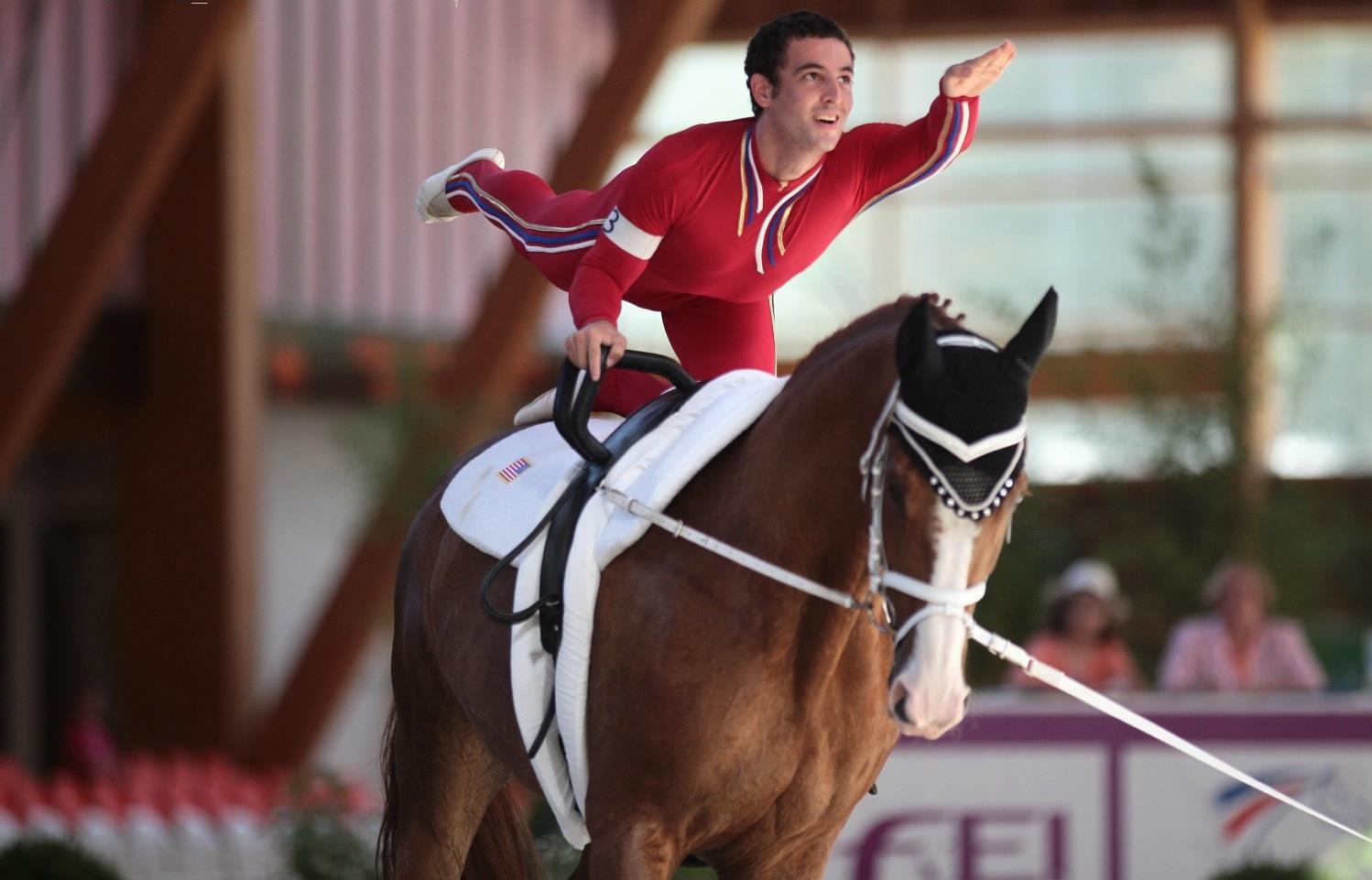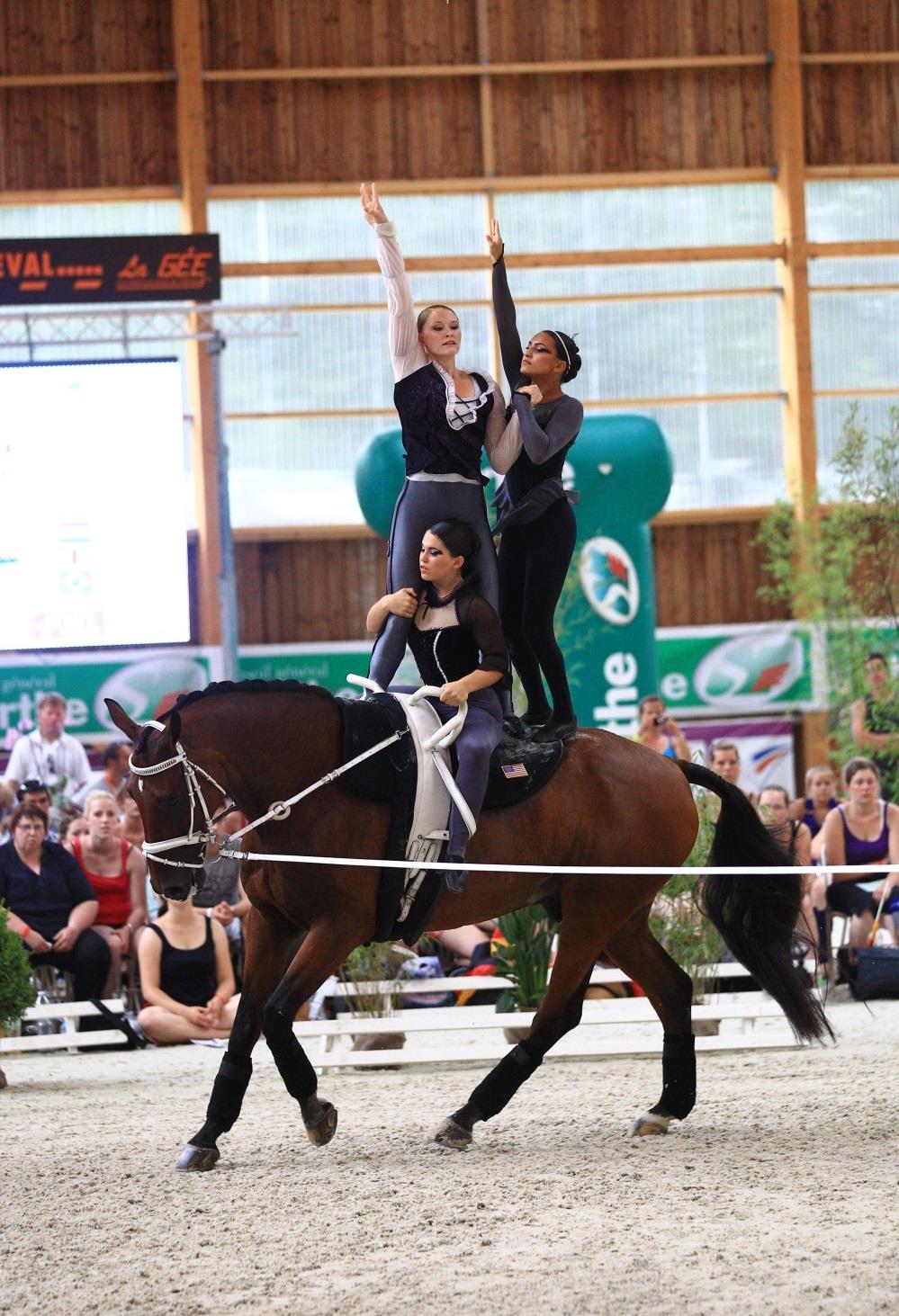Vaulting—gymnastics on horseback—is one of the world’s oldest equestrian sports. And while it might look exotic to those of us more used to riding or driving, the sport of vaulting offers a wealth of great training for any equestrian, regardless of discipline. Not surprisingly, many vaulters have fast-tracked into other disciplines, like dressage, jumping, and eventing, after building a strong foundation in vaulting.
So what can you get from vaulting?
We asked two vaulting pros what their sport can teach all equestrians. Carolyn Bland, a gold medalist at the 2010 Alltech FEI World Equestrian Games and bronze medalist at the 2017 Junior World Championships, was the American Vaulting Association’s Trainer of the Year in 2006 and 2010 and holds the FEI Level One Coaching Certificate; based in Woodside, Calif., she conducts clinics nationwide. Andrea Selch coaches vaulting athletes at Triangle Equestrian Vaulting in Hillsborough, N.C., whose vaulters range in age from seven to 53. She holds the FEI Level One Coaching Certification for Equestrian Vaulting.

(www.barny-th.de)
A Deeper Appreciation for Longeing
“Before I got involved with vaulting, I thought of longeing as merely a way of getting a horse to warm up quickly or blow off steam or a way to check for bucks,” said Selch. “I knew there were some longeurs that were better than others, but I did not know there was such an art or science behind it.
“After five years of longeing, I have learned that longeing is a special and very important activity with the horse. Longeing helps the horse be a better riding horse, and the longeur can learn a lot about the horse from longeing it. Some things about the horse that you can only feel as a rider, you are able to see when you are longeing the horse: impulsion, engagement, collection, stretching long and low, stiffness or suppleness, and the different shapes of different frames.
“The most important part of learning to longe, though, is building a stronger relationship with your horse. My horses and I are deeply related. They watch and listen to me even when they are off the longe line—my old trot horse Prince will listen to my voice even when someone else is riding him out in the field. That may not be a good thing all the time, but it does demonstrate the way that longeing forges the connection between horse and human.”
Core Strength and Flexibility
“Equestrian vaulting can be a great advantage when used for cross-training for a rider,” Bland said. “Vaulting classes begin with a fitness portion—running, jumping, and strength training—and fitness can greatly improve riding in all disciplines.”
Vaulting’s compulsories and freestyle moves, as well as the warm-up and fitness training, all build an equestrian's core strength, in particular. Core strength, in turn, is what allows the rider to develop an independent seat and hand, keys to good equestrianism.
Balance—and Confidence
An independent seat is impossible without balance, and vaulting presents great opportunities for an equestrian to develop and improve balance. In vaulting, the longeur controls the horse, and the vaulter uses handles and a big, comfortable pad—but no stirrups or reins. “Exercises in all gaits without stirrups or reins will help with an independent balance,” Bland said.

Photo courtesy of Carolyn Bland.
“Vaulting will help with a rider’s balance—that’s kind of a no-brainer to me,” said Selch. “But I also think being able to recover from losing your balance, which you can do while vaulting, as well as falling or jumping off—all these things build a rider's confidence.”
A Better Seat
“The basic seat in vaulting is very similar to the riding seat: shoulder, hip, and heel are aligned, the back is straight, chest up, eyes forward,” explained Selch. “The seat is probably the first vaulting lesson that everybody gets. I ask my beginning vaulters to get into position, then I ask them to do various things with their arms, such as making big circles or reaching for the sky. These motions temporarily undermine their seat and so they must learn to correct it.”
Trust
Think you’re too old to try a little vaulting? Think again. A basic vaulting class can help you learn to trust both the horse’s motion and your own seat, as well as hone or improve your skills. “Many adult riders become nervous and tense, and vaulting can help with the forward feel and balance, because the vaulter can grip the handles at any stage, so they begin to gain trust in their abilities and trust in their seat,” explained Bland.
The longeur is also part of the trust that forms between horse and vaulter.
“The longeur has complete control of the horse,” said Selch. “The vaulter needs to trust that the longeur has the horse completely in his or her control—that the horse knows the aids and the commands for transitions up and also down.”

(www.barny-th.de)
Team Skills
Even an individual vaulter is part of a three-way team that includes vaulter, longeur, and horse. The team gets even bigger when a group of vaulters performs together—and that takes excellent communication, mutual responsibility, and the ability to step up to the plate for your teammates.
“There is nothing quite like being held aloft by two teammates on a cantering horse to teach trust and bravery!” said Selch.
Harmony with the Horse
Vaulters use all these building blocks—core strength, flexibility, balance, trust, and an independent seat—to create deep harmony with their horses. That’s something every equestrian wants, whether they’re competing or riding for pleasure. Performing without stirrups or reins, vaulters must achieve it.
“Sitting all three gaits, without access to reins or stirrups, allows the rider to feel and join with the horse’s motion,” explained Bland.
“Accomplished vaulters are extremely harmonious, and so the horses just go for them,” Selch said. “Both horse and vaulter look happy.”
To learn more about vaulting, visit the American Vaulting Association and US Equestrian’s vaulting page.
Want more articles like this delivered to your inbox every week? Sign up here to receive our free Equestrian Weekly newsletter.
This article is original content produced by US Equestrian and may only be shared via social media. It is not to be repurposed or used on any other website aside from usequestrian.org.


